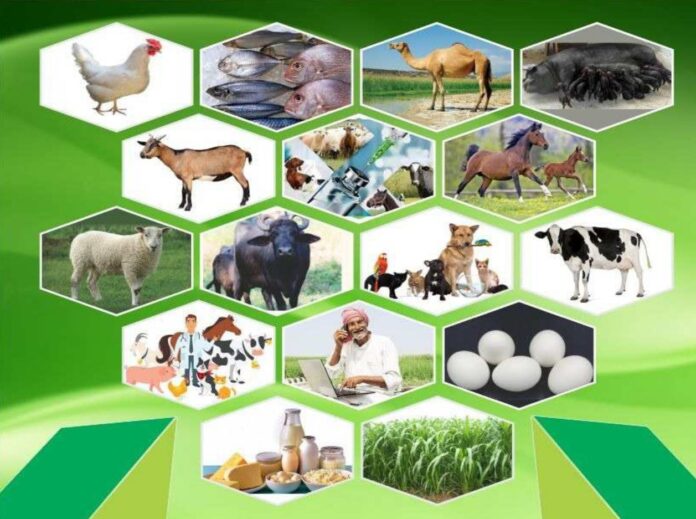Marker Assisted Selection (MAS)
Vaishali Pareek1*,Anju kumari1, Radha Rani Swami, Yashmita Shekhawat1,
1Department of Animal Genetics and Breeding, College of Veterinary and Animal Science, Bikaner, RAJUVAS
*Corresponding author:pareekvaishali3@gmail.com
Marker Assisted Selection (MAS) is an advanced method of selection in breeding programs that utilizes molecular markers, specific DNA sequences associated with genes controlling desirable traits, to aid in the selection of individuals for breeding. Through the identification and analysis of molecular markers linked to target traits, MAS allows for precise selection of individuals with desired genetic characteristics. This approach enhances breeding efficiency by reducing the need for extensive field trials and laborious phenotypic evaluations, thereby saving time and resources. MAS also enable breeders to capture genetic variation not evident through traditional methods, leading to higher genetic gains in breeding programs. By facilitating the selection of complex traits controlled by multiple genes, MAS represents a powerful tool for accelerating the development of improved crop varieties, livestock breeds, and other organisms with desirable traits.
TYPES OF MARKERS:
DIRECT MARKERS: Functional polymorphism in the gene that controls variation in the trait or loci for which functional polymorphism can be genotyped.
LD- MARKERS: loci in population-wide LD (linkage disequilibrium) with the functional mutation;
LE-MARKERS: Loci in population-wide linkage equilibrium with the functional mutation but which can be used for QTL detection and MAS based on within family LD.
For the purpose of genetic improvement, markers can be used to enhance within-breed selection based on GAS (gene assisted selection), LD-MAS, or LE-MAS programs to capitalize on between-breed variation by selection within a cross.
A molecular score (MS) is derived using the markers associated with the desirable traits.
This molecular score (MS) in selection, in combination with phenotype or EBV (Expected breeding value) derived from phenotypic information can be used in three distinct ways
1) Tandem selection, with selection of candidates on MS followed by selection on phenotype or EBV
2) Index selection on a combination of MS and phenotype or EBV
I = b1MS + b2EBV (Lande and Thompson, 1990)
3) Pre selection on MS (or an index of MS and EBV) at a young age, followed by selection on an updated EBV at a later age
After selection using molecular score and expected breeding value, the response to MAS can be evaluated at following levels:
- Changes in gene frequencies for the selected marker locus
- Changes in gene frequencies in the targeted locus (if different from the selected loci);
- Effect of the targeted locus or region on the trait in the target population
- Improvement of the population or selected individuals in overall genetic level for traits of interest.
Advantages of Marker Assisted Selection
Marker Assisted Selection (MAS) offers several advantages in breeding programs:
- Precision: MAS enables precise selection of individuals with desired traits by targeting specific genes or markers associated with those traits. This precision allows for more efficient and effective breeding strategies.
2.Efficiency: By focusing on genetic markers rather than relying solely on phenotypic traits, MAS reduces the need for extensive field trials and laborious phenotypic evaluations. This saves time and resources, accelerating the breeding process.
- Enhanced Genetic Gain: MAS facilitates the capture of genetic variation that may not be evident through traditional selection methods. This leads to higher genetic gains in breeding programs as breeders can select for desired traits more effectively.
- Complex Trait Selection: MAS enables the selection of complex traits controlled by multiple genes, which may be difficult to achieve through traditional methods. This allows breeders to target traits such as disease resistance, stress tolerance, or yield potential more efficiently.
- Reduced Generation Time: By identifying markers linked to desired traits at early stages of plant or animal development, MAS reduces the generation time required for breeding new varieties or lines.
- Increased Selection Accuracy: MAS provides breeders with a more accurate prediction of an individual’s genetic potential, reducing the risk of selecting individuals with undesirable traits.
- Broad Applicability: MAS can be applied across various species and breeding programs, including crops, livestock, and aquaculture, making it a versatile tool for breed improvement in agriculture and beyond.
Overall, Marker Assisted Selection offers significant advantages in terms of precision, efficiency, and genetic gain, making it a valuable tool for modern breeding programs aiming to develop improved varieties with desirable traits.



